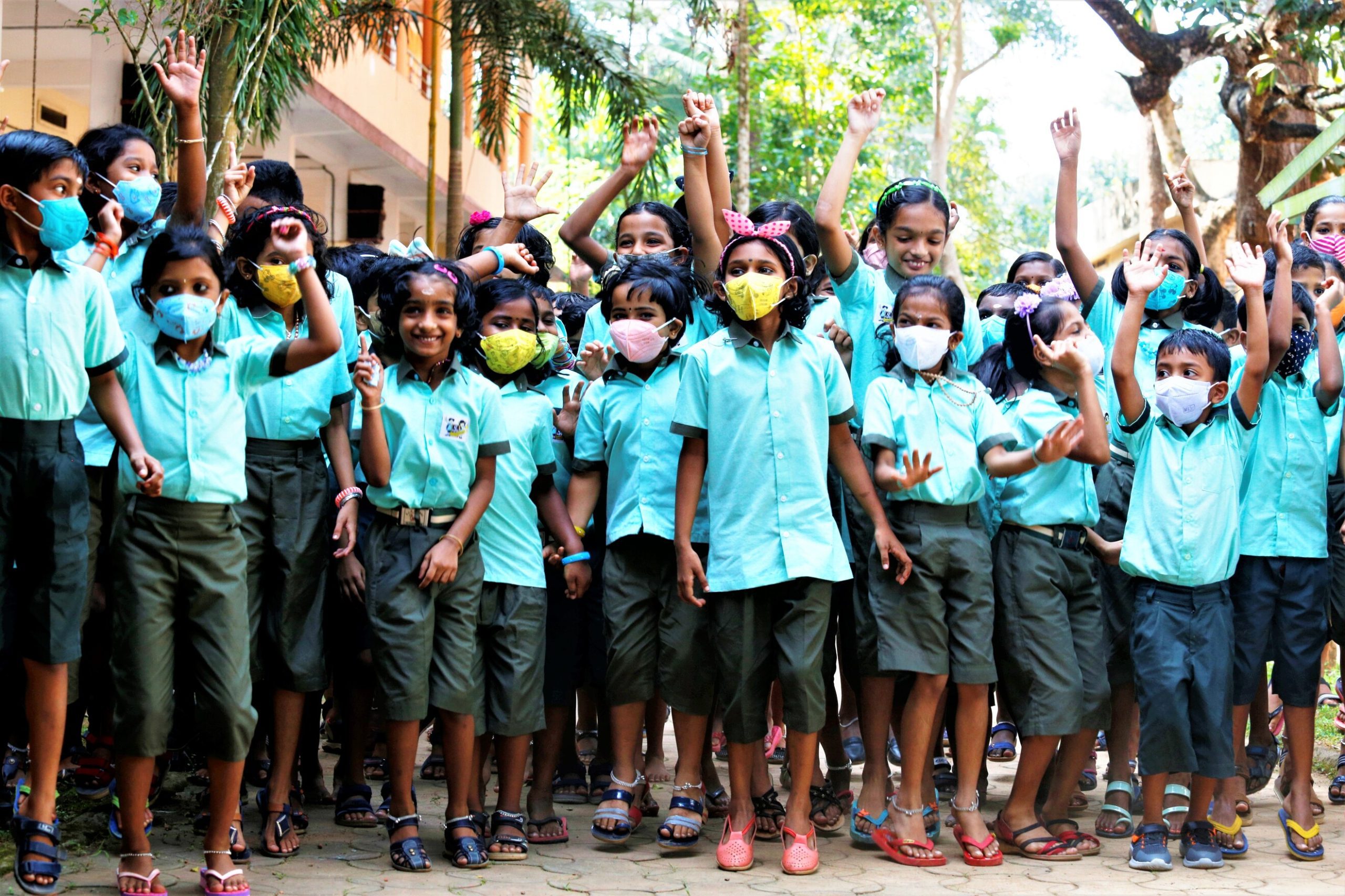There is much more to the Valayanchirangara lower primary school, which began the gender-neutral uniforms trend that others have emulated.

Students in gender-neutral uniform at Valayanchirangara school. (Syed Shiyaz Mirza/South First)
The Kerala government may have backtracked on its proclaimed policy on gender-neutral schools, but for the state-run school that was the first to introduce unisex uniforms three academic years ago, it is business as usual.
On 25 August, Chief Minister Pinarayi Vijayan made it clear his government would not unilaterally impose gender-neutral uniforms on any state school, leaving it to the institutions to take the final call.
Stiff resistance from orthodox Islamic groups is believed to have prompted his LDF government to roll back its policy, formally introduced in all schools across the state on 24 July, following recommendations from the Kerala State Commission for Protection of Child Rights.
The shift in the government’s stance was welcomed by Muslim community leaders, and defused a raging controversy — at least for the time being.
But both the controversy and Vijayan’s policy rollback seem to have left unaffected the state-run lower primary school at the Valayanchirangara village near Perumbavoor in the Ernakulam district, where it all began.
Like the rest of the country, Kerala for decades witnessed no resistance to gender stereotypes in school uniforms: shorts or trousers for boys, blouses and bulky skirts for girls.
And when it decided against the old dress code three years ago, the Ernakulam institution became the first school in the state to adopt unisex uniforms for its students, irrespective of their faith.
Gone were the bulky skirts for the girls; shirts and knee-length shorts for both them and the boys became the norm.
The girls loved it; as Class 5 student Sivananda Mahesh said, it was very comfortable. “I can play well in this uniform, which is quite different from that of my friends in other schools,” she said.
“I feel very happy with this school, where the uniform is very convenient. My friends from other schools are envious of the uniform as well as the facilities at the school, which match any top private school. Our teachers are very loving and caring,” said Minna Fathima, a Class 3 student.
More importantly, the parents of the female students, across faiths, welcomed the initiative as the new uniform facilitated easy movement for their daughters.
“My daughters Afsa Sehra and Aisha Bhanu are studying in Class 1 and LKG, respectively, in the school. I chose this school for my daughters mainly because of the uniform and the quality of education here. I don’t mind what the orthodoxy says. My daughters are happy and confident in the uniform here,” said CA Ashraf, a manager with a private telecom service provider.
“Through local-level mobilisation of resources, the school has ensured excellent infrastructure that can match top private schools. Teachers are dedicated. Why should my children lose the opportunity to study in an equal space with higher standards?” asks Ashraf.
Interestingly, most of the 756 students at the 105-year-old school hail from Muslim and Christian families.
Explained Parent Teachers’ Association (PTA) president V Vivek: “In our experience, the concept goes well with parents of different religions.”
The development created national and international headlines.
In breaking away from tradition, the lower primary school under Kerala’s General Education Department also signalled the start of a silent revolution.
Over the next two years, its move inspired over a dozen schools in the state to shift to gender-neutral uniforms.
The Valayanchirangara school’s decision to stick to its unisex uniform policy despite the ruling LDF’s recent ambivalence may have been influenced by the stand of the CPI(M) on the issue.
The CPI(M), the largest constituent of the ruling LDF, has ignored the coalition government’s policy rollback, and made it clear it would support any school that introduced gender-neutral uniforms based on a consensus.
But attributing the school’s decision to a political party’s statement may be too simplistic as well; a strong PTA influences much of the school policies.
“Only a section of religious leaders are opposing the gender-neutral uniforms,” said PTA president Vivek. “Many Muslim families in this locality feel there is nothing wrong with it.”
Echoing the sentiments of the students, he said his children can “easily do any activity in this uniform”.
Like him, former PTA president Benoy Peter was nonplussed by all the brouhaha. “We can’t understand the rationale behind the new wave of protests,” he told South First. “There are at least two engineering colleges under Muslim management where unisex uniforms are in force.”
Peter, also the executive director of the Kochi-based NGO Centre for Migration and Inclusive Development, was the driving force behind the gender-neutral revolution at the school.
Recalling the early days, he said only a single parent objected when the school introduced the gender-neutral uniform.
“It was only when the PTA then explained to him how it would facilitate easy movement and help the girls in their physical activities that he was convinced,” Peter said. “Since then, there has been no opposition.”

Students of Valayanchirangara LP school wear gender-neutral uniforms. (South First/Syed Shiyaz Mirza)
Headmistress KA Usha, too, spoke of how, belying fears of backlash, the parents wholeheartedly embraced it. “We could implement the proposal without facing any protests,” she said.
Interestingly, even the local panchayat lent its support. Panchayat President NP Ajayakumar, also a former School Management Committee chairman, said Kochi-based designer Vidya Mukundan was approached to come up with a unisex uniform that had “style and elegance”.
“Now, we are happy that the school is forcing the whole state to rethink gender stereotypes,” Ajayakumar said.
Some leading women’s rights groups have also come out to support the unisex-uniform drive initiated by the school, saying it would help bridge the gender gap.
The decision to opt for unisex uniforms, perhaps, should not be viewed in isolation as far as this primary school is concerned; the move is in keeping with the forward-looking manner it is run.
For instance, it was the first government school in Kerala that opted for English as the medium of instruction, replacing the mother tongue of the local population, Malayalam. In another first in the state, the school introduced a group health insurance policy for all its students.
To enhance the quality of learning, the school has implemented a social audit of teachers with the collaboration of the Department of Social Work at Sree Sankaracharya University of Sanskrit — yet another first in Kerala.
And the school uniform is not the only area where gender sensitivity is reflected: It is today at the heart of the 756-student school, said teacher KP Suma. “We are ensuring easy mingling of boys and girls without bothering about gender,” she explained.
In keeping with its ethos, the school’s pre-primary section has its own specially-prepared “gender-neutral textbooks”, which aim to sensitise pupils about gender parity from a tender age.
The step was taken, explained headmistress Usha, because “in India, pre-primary children lack good common textbooks”, which do not promote gender parity.
“So, we prepared our books with teachers preparing the content and a former student preparing drawings,” she said.
Some of these books feature images of women driving vehicles and men preparing food in the kitchen. The idea that is conveyed to the kids is: No job or task is gender-specific.
The school recently prepared a logo that promotes gender equality. Alongside, it also strives to teach its students to respect women. Thus, except for the school bus driver, the school boasts of an all-woman team of both faculty and administrative and other staff.
The headmistress said the steps the school adopted helped increase the number of new enrolments.
“Across the state, there is a preference for English-medium schools under private management, and as a result, government schools are facing closure,” she said. “But our school, which had hardly 400 students a decade ago, now has 377 boys and 379 girls.”
The new uniform, she said, “has evoked a lot of goodwill”.
The Sunni Students’ Federation (SSF), an Islamic organisation, calls the unisex uniform a “political tool” for the ruling Left.
“This is a ploy to divert public attention from some crucial issues the state faces,” argued Jafer Neroth, an SSF leader. “Going by physiology, men and women are different, and the gender-neutral policy is the denial of diversity.”
Peter dismissed Neroth’s contention, saying the uniform would help “ensure gender justice and equality”.
“We are promoting it as a step to bridge the gender gap,” he told South First. “Many misconceptions of boys would go away with the introduction of such a common uniform.”
More importantly, said teacher Suma: “The new uniform boosted the morale of boys and girls; it boosted their confidence.”
The most important voice, perhaps, is that of the students. Do they want to continue with it?
“The skirt-and-blouse uniform of other schools looks very uncomfortable. We feel a lot of ease. It’s my luck to be in this school,” said Fathima.

Apr 25, 2024

Apr 25, 2024

Apr 25, 2024

Apr 25, 2024

Apr 25, 2024

Apr 25, 2024